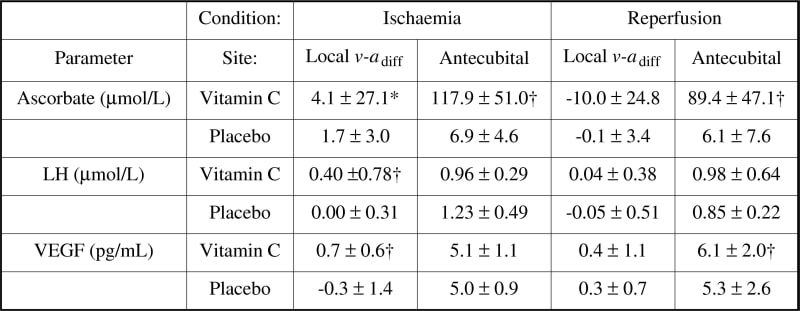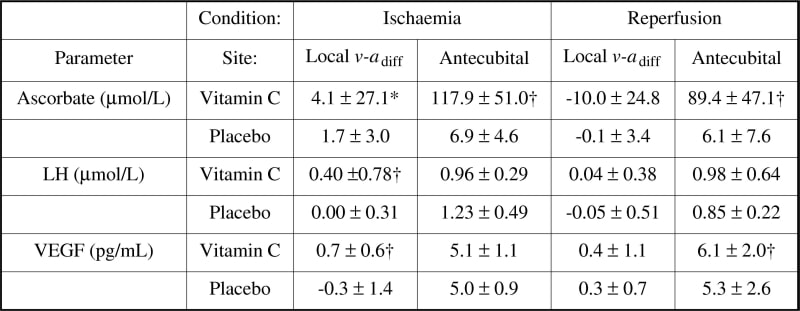The present study examined changes in reactive oxygen species (ROS) and vascular endothelial growth factor (VEGF) protein during ischaemia-reperfusion surgery. Twenty two patients scheduled for either elective abdominal aortic aneurysm (AAA) repair or infra-inguinal bypass (IIB) surgery were recruited. Patients were assigned double-blind to either a vitamin C (AAA: n = 6, IIB: n = 4) or placebo (AAA: n = 7, IIB: n = 5) group. Following anaesthesia, each patient received an intravenous infusion of either 20ml saline (placebo) or 20ml saline containing 2g of L-ascorbate (vitamin C). Blood was obtained from local arterial and venous lines proximal to the site of repair and peripheral antecubital vein at the end of cross-clamp application (ischaemia) and within 10 min after clamp release (reperfusion). Samples were assayed for ascorbate, lipid hydroperoxides (LH), transition metal ions and α-phenyl-tert-butylnitrone (PBN)-adducts as previously described (Bailey et al., 2004) and total VEGF protein concentration via radioimmunoassay. Vitamin C infusion increased the venoarterial concentration difference (v-adiff) for ascorbate during ischaemia whereas a decrease was observed following reperfusion (Table 1). Vitamin C also increased LH and VEGFv-adiff during ischaemia. Electron paramagnetic resonance (EPR) spectroscopy provided direct evidence for an increase in the concentration of PBN-adducts and ascorbate radical (Anull;-) in peripheral venous blood during reperfusion in the vitamin C group (PBN-adducts: ischaemia = 4258 ± 2125 vs. reperfusion = 5984 ± 2361 arbitrary units (AU), P < 0.05; Anull;-: ischaemia = 1188 ▒ 284 vs. reperfusion = 1415 ▒ 202 AU, P < 0.05). Nuclear hyperfine splittings were consistent with the trapping of secondary oxygen (alkoxyl or hydroxyl) and carbon (alkyl)-centred species comparable to those generated during metal-catalysed reductive decomposition of LH. Manipulation of the EPR signal intensity of Anull;- following in vitro addition of desferrioxamine mesylate and Fe(III)-EDTA to vitamin C-supplemented serum obtained during reperfusion confirmed that iron was available for oxidative catalysis. The present findings suggest that high-dose ascorbate may increase local ROS generation during ischaemia through initiation of a Fenton reaction. Local release of reduced free iron during reperfusion may prove the catalyst for the secondary radicals detected in the peripheral circulation. The ‘downstream’ increase in VEGF protein may prove an adaptive response to ‘salvage’ vascular homeostasis.
King's College London (2005) J Physiol 565P, C16
Communications: Prophylactic L-ascorbate infusion stimulates local release of vascular endothelial growth factor during ischaemia-reperfusion surgery in humans; evidence for redox-regulation
Bailey, Damian Miles; Raman, S ; McEneny, Jane ; McKeeman, Gareth ; Young, Ian S; Hullin, David A; Davies, Bruce ; McCord, Joe M; Lewis, Michael H;
1. Departments of Anesthesiology and Surgery, University of Colorado Health Sciences Center, Denver, CO, USA. 2. Department of Surgery, Royal Glamorgan Hospital, Mid-Glamorgan, United Kingdom. 3. Department of Medicine, Queens University Belfast, Belfast, Ireland. 4. Department of Physiology, University of Glamorgan, Pontypridd, United Kingdom. 5. Webb-Waring Institute, University of Colorado Health Sciences Center, Denver, CO, USA.
View other abstracts by:
Table 1. Proximal and distal metabolic responses to intravenous vitamin C Values are means ± SD; *main effect for condition (P < 0.05 two-way repeated measures ANOVA); †different between groups for given condition and site (P < 0.05 Mann-Whitney U test).
Table 1. Proximal and distal metabolic responses to intravenous vitamin C Values are means ± SD; *main effect for condition (P < 0.05 two-way repeated measures ANOVA); †different between groups for given condition and site (P < 0.05 Mann-Whitney U test).
Where applicable, experiments conform with Society ethical requirements.


